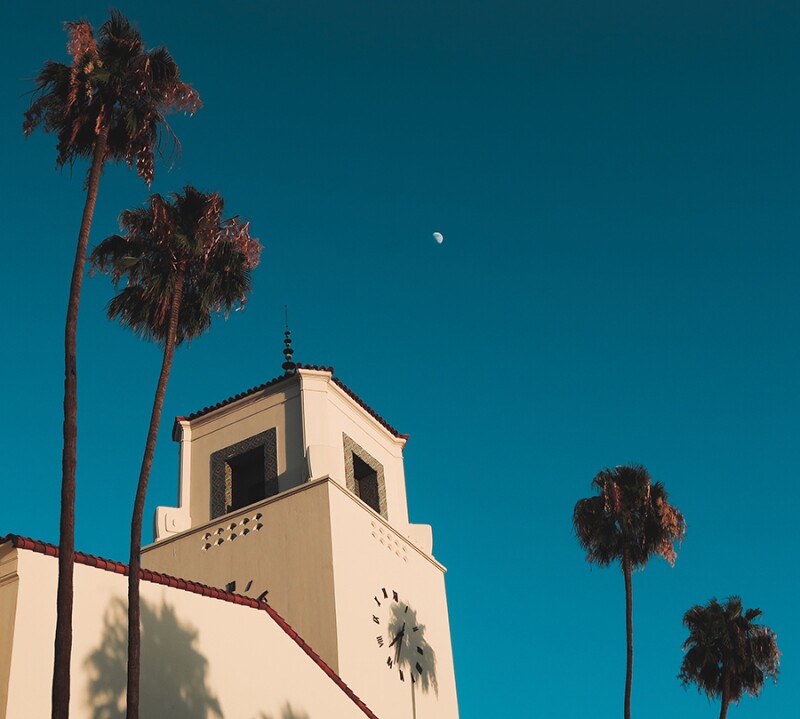Los Angeles has always celebrated the next big thing. Billboards rotate weekly, yesterday’s darlings quickly fall out of favor, and the only thing worse than growing old is fading from memory.
In a town where so much is temporary, it’s a wonder LA has any remaining history at all. But glimpses of the old LA are everywhere, for those who are willing to look. Here are six spots that have seen it all, and still have stories to tell.
The Musso & Frank Grill
There are a handful of L.A. restaurants older than this one, but none that have the venerable literary and film history of Musso & Frank. The legendary establishment, founded in 1919, was a favorite haunt of novelist Raymond Chandler—who looked upon the city with a mixture of scorn and affection. The famous noir stylist wrote chapters of The Big Sleep in the bar and sent his avatar, Phillip Marlowe, to eat there in The Long Goodbye.
Local tip: Order the fettuccine Alfredo, which is still prepared using a decades-old recipe from Alfredo’s in Rome, which was imported to Los Angeles by movie stars Douglas Fairbanks and Mary Pickford.

L.A. Union Station is a grand example of the Spanish mission deco style.
Photo by Louka Lambot on Unsplash
Union Station
Union Station is as stunning as it is rich in history, and continues to be a vital hub for L.A. rail and bus transport. On the outside, the building resembles an art deco riff on the old California missions; inside, the travertine, terra-cotta, and inlaid linoleum floors show the sort of detail work so rare in modern train stations.
Local tip: Settle in to one of the giant leather chairs in the cavernous waiting room and immerse yourself in L.A.’s seedy side with Chandler’s afore-mentioned noir classic, The Big Sleep. (Without a ticket you can’t enter the waiting room, but can at least enjoy the Navajo patterning on the station’s tile floors.)
Canter’s Fairfax
Canter’s is one of those select few LA institutions that everyone ought to experience. The deli has served up its signature sandwich—corned beef and pastrami on rye—and classics like hash, lox, and cream cheese on a toasted bagel since 1931 (1953 at the current location). Tour bus passengers crowd the counter in the daytime, but at night Canter’s still feels like old L.A.
Local tip: Visit in the wee hours when crowds of actors fresh from a long day at the nearby studios are prone to wander in for a snack.
Bronson Caves
These “caves” in Griffith Park are actually tunnels left behind by a rock quarry that dates back to 1903, and they have a longer list of lead roles than any movie star on the planet. For years, the caves and surrounding canyons were the go-to spot in Los Angeles for Wild West scenery. Perhaps their most notable role was as the Bat Cave entrance in the 1960s Batman TV show, starring Adam West.
From Franklin Ave. in Hollywood it’s just a short hike up the hill and around a barricade. Don’t worry, you’re not breaking the law—and even if you were, the caves would make an excellent spot to hide out.
Local tip: Run out of the cave, yelling, “To the Batmobile!”—you know you have to.
El Cholo Café
You can’t understand LA’s culinary scene without paying homage to the influence of Mexican food. El Cholo Café is not only the city’s longest-standing restaurant of its kind, but it’s also the most influential. On the menu, each dish has a date beside it to show the year it was added to the kitchen’s repertoire.
Local tip: Order Carmen’s Original Nachos (1959), which longtime employee Carmen Rocha brought with her from San Antonio—marking the first time a restaurant served nachos in California.
John Sowden House
Often called “The Jaws House” for the way the stone block façade resembles the open mouth of an approaching shark, this home was designed by Lloyd Wright (son of Frank Lloyd Wright). The home dates back to 1926 and feels like an urban fortress belonging in a black-and-white movie.
Dr. George Hodel, a suspect in the notorious Black Dahlia murder case of 1947, lived in the house from 1945–1951. In an “only in Hollywood” twist, Hodel’s son, a retired detective, penned a 2006 bestseller—Black Dahlia Avenger: The True Story—fingering his father as the culprit.
Local tip: If the “true story” seems too much, scout the house with a copy of James Ellroy’s classic neo-noir novel, The Black Dahlia.
One final tip: Check out the HistoricPlacesLA project to learn more about old LA.
>>Next: Plan your visit with AFAR’s Los Angeles Travel Guide











